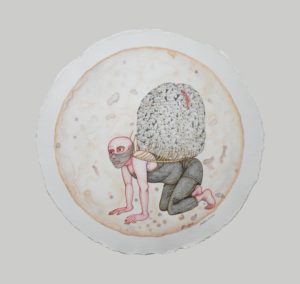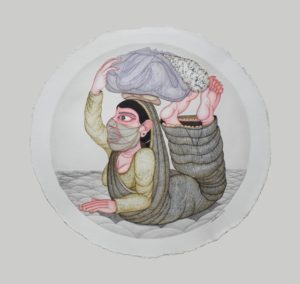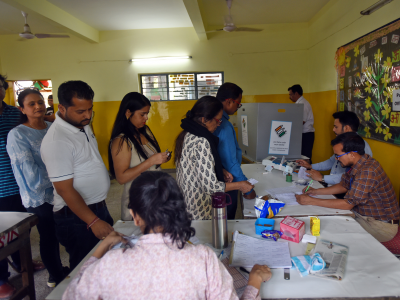The three-month-long lockdown brought on untold misery and suffering for the migrant labour population across India. Anjan Modak’s works capture their plight highlighting the injustices they face
Mirroring the situation we live in, artist Anjan Modak’s work is a perfect representation of the adversities of these unprecedented times.
Known for depicting the woes of the common man, his current new series ‘Fragmented Life’, puts the spotlight on the labour class. Put together by Emami Art, the exhibition has on display 19 new works.
Moved by the various news stories about the suffering of migrant workers that came in from across the country, Modak started working from mid-April. Observing and taking notes of several news stories and articles, what shook him the most was the shocking incident of migrants being run over by a train in Aurangabad.
“The lockdown wreaked havoc on the migrant labourers, who were left starving and homeless in many big cities of India and unprotected against the virus. The entire nation was shocked to witness the incredible suffering and deaths of the migrant workers making their long journey home on foot in the sweltering heat of the summer,” reads the note on the show.
It was these very sights of suffering that spoke to Modak and the artist in him was implored to do something about it. “While in the first phase of lockdown, people were house-bound and happy, its extension brought in distress. With most of their savings dried up, the fear, anxiety and shock of an uncertain future set in. I studied the signs of depression that became visible on their faces,” says Modak.
Showing these dismal experiences of the migrant workers or the “spine of the country” in the hard times of pandemic, Modak painted the series of small size, circular-format paintings.
One must note that for Modak, focusing his attention on the labour class is quite personal. Taking us back to his childhood, he shares the story of his learned but impecunious family.

Soon after he was born in Kolkata, his parents moved to Delhi, where his parents had to take up a job as masons for sustaining themselves. He recalls how his mother would take him along to the site of work at times. It was a life of struggle and uncertainty which continued for quite some time (15-16 years) before his father secured a job in a factory.
“Being graduates from Kolkata who were well adept with street plays, my parents naturally had an inclination towards culture and art. After the day’s work at the factory, many of the labourers would get together with my father and indulge in poetry and other art forms. My interactions with the labourers hence has been long,” adds Mondal.
This interaction still continues to this day as Mondal lives in a locality which has gold factories in its proximity. Here he has observed the various facets of the worker’s lives, who have come down from their villages and live in single rented rooms.
“Anjan, an insider and well familiar with the complexity of the subaltern mentalities, marked by the sense of subordination, anomie and insecurity, does not represent the subaltern life merely objectively, but as a layered, fragmented narrative of body, history and the city.
Showing mastery in narrative figuration, these works invoke no triumph of labour, but an aesthetic of the everyday life, connecting the mundane, commonplace objects, gestures, memories and emotions to the wider, dominant social and political forces shaping the popular life of the society, ” says the curator.

The figures in his works are highly emotive and express their despair quite evidently. A good number of his works have been enclosed in circles, a format he is exploring for the first time. The circles are not just formats but symbolic of their rough lives.
“One can notice that the circles are not perfect and are uneven in all my works. I have consciously torn out the paper after creating the work, which gives it an imperfect finish,” explains Modak.
Another factor that led to the use of the circle as a composition sense is an aspect of school that we are all too familiar with. “Teachers would always use circles to mark and highlight something wrong in all answer sheets,” adds Modak.
A look at the figures enclosed in the small circles also portrays a feeling of being trapped in a space, and that’s exactly what the artist hopes to invoke. Each of the works depicts the hopelessness of migrant workers as they look at an uncertain future and struggle to make their way back home.
The exhibition can be viewed at Emami Art website till August 31
(Cover: Modak’s work titled ‘Exile in the construction’)





